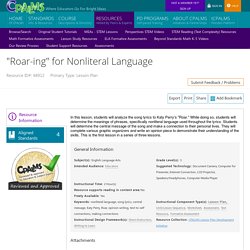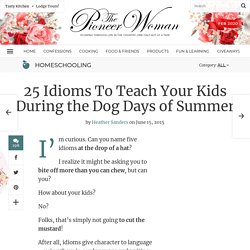

Lesson Plan: Understanding Idioms – Making Thinking Visible with Technology. Grades 2-3 Lessons: Fun With Figurative Language. Going on a Text Hunt Standard Met: CCSS.ELA-Literacy.RF.2.4 Objective: Use a graphic organizer to recognize and record figurative language from a text What You Need: Owl Moon, by Jane Yolen, chart paper, marker, graphic organizer What to Do: Being able to recognize figurative language supports literacy and burgeoning creative writing skills.

Becky Spence, a former classroom teacher from North Carolina, supports figurative language learning by going on a hunt—a text hunt! “A text hunt is a great way to help students understand that figurative language should not always be taken literally. Spence begins by reading aloud Owl Moon. To model, she turns to the first page and rereads it aloud. Next, in a facing column that she titles Ordinary Text, she writes, “What the author is really trying to say is that the trees didn’t move. Then, she hands out copies of an organizer divided into two columns titled Extraordinary Text and Ordinary Text, or has students make their own. Roar-ing for Nonliteral Language In this lesson, students will analyze the song lyrics to Katy Perry ...
Lesson Plan Template: General Lesson Plan Learning Objectives: What should students know and be able to do as a result of this lesson?

Students will be able to:identify examples of nonliteral language using the lyrics from the song "Roar. "determine the nonliteral meanings of certain words and phrases throughout the song lyrics in "Roar. "determine the central message using the song lyrics from "Roar. "write an opinion piece with support and include a text-to-self connection. Prior Knowledge: What prior knowledge should students have for this lesson? 25 Idioms To Teach Your Kids During the Dog Days of Summer. I’m curious.

Can you name five idioms at the drop of a hat? I realize it might be asking you to bite off more than you can chew, but can you? How about your kids? No? Folks, that’s simply not going to cut the mustard! After all, idioms give character to language – using them in our language and writing is like killing two birds with one stone. Though idioms can’t be explained by assessing the meaning of each of the individual words, they still expand our ability to communicate as clear as a bell. Unfortunately, idioms are one of the reasons learning a new language can be so difficult. The idioms you may be most familiar with are often directly related to where you grew up.
For instance, I’ve not once used the English idioms, “Bob’s your uncle” or “Do a Devon Loch.” But, I regularly use other idioms, like “Man, she’s got a chip on her shoulder” or “Ugh, I’m sick as a dog.” Sometimes idioms are heard through the grapevine in your specific areas of interest and social groups. 403 Permission Denied. The Synonym/Antonym Files, Lesson Plans - The Mailbox. Root Words, Roots and Affixes. Many English words are formed by taking basic words and adding combinations of prefixes and suffixes to them.

A basic word to which affixes (prefixes and suffixes) are added is called a root word because it forms the basis of a new word. The root word is also a word in its own right. For example, the word lovely consists of the word love and the suffix -ly. In contrast, a root is the basis of a new word, but it does not typically form a stand-alone word on its own. For example, the word reject is made up of the prefix re- and the Latin root ject, which is not a stand-alone word. Common Latin and Greek roots Download a copy of the Common Latin Roots chart shown below. Download a copy of the Common Greek Roots chart shown below. Prefixes and Suffixes, Plus Roots No-Prep Printables by Rachel Lynette. These 40 ready-to-use worksheets (with answer keys) are designed to help your students use affixes correctly and to understand new words by looking at affixes and word roots.

This resource is correlated with Common Core Standards for grades 3-5 (standards included, see preview). This resource is divided into four sections: Prefixes, Suffixes, Prefixes and Suffixes, and Roots. At the start of both the Prefix and the Suffix sections, there are several worksheets that introduce students to some of the more common affixes. The rest of the sections are devoted to more practice using these affixes with a short multiple choice quiz at the end.
The Prefix and Suffix section provides opportunities for students to practice using prefixes and suffixes together. The first two pages in the Roots section focus on just three common roots and their meanings in order to introduce the concept. 15 Engaging Ways to Teach Prefixes and Suffixes. How to Teach Prefixes (Mini Teaching Guide + Download) Are you looking for the best way to teach prefixes? This mini teaching guide shows you how! And don’t miss the free printable prefix list, along with activities that help your child master words with prefixes. What Is a Prefix? A prefix is a word part that is placed in front of a base word. Common prefixes include pre, bi, and anti. A prefix usually changes the meaning of the base word. Think about the word happy. The Two Most Common Prefixes The most common prefixes are un and re. Un means not (unhappy = not happy) or the reverse of, or opposite of (as in untie). Re means again (redo = do again) or back (as in repay).
If you’re interested in learning more about prefixes, download and print this list of 90 common prefixes. Tips for Adding Prefixes Tip 1: The spelling of the base word never changes. Tip 2: Be aware that double letters can occur. Other examples where double letters occur include misspell, irregular, and unnoticeable. Tip 3: Watch out for prefix look-alikes. Common Suffixes and their Meanings. How to Teach Suffixes (Mini Teaching Guide + Download) Welcome to our mini teaching guide on suffixes! In this post, you’ll find many different tools to help you teach suffixes to your child, as well as downloadable resources and activities. Let’s dig in! What Is a Suffix? A suffix is a word part that is placed at the end of a base word. Common suffixes include ED, ING, and EST.